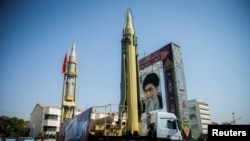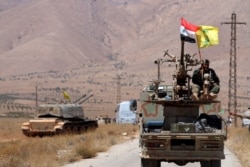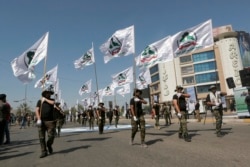Story updated: July 3, 2019, 6:55 p.m.
WASHINGTON — Escalating tensions between the United States and Iran are exposing potentially contrasting U.S. assessments of the threat Tehran represents to Washington and its allies and interests in the region.
The narratives coming from top officials at the White House, the Pentagon and the State Department portray an Iranian regime that is either weaker and more desperate or more brazen and emboldened.
Now, the extent to which one of those narratives may be more accurate could be crucial in determining what happens next with Tehran threatening to produce more low-enriched uranium in further violation of the 2015 nuclear deal, also known as the Joint Comprehensive Plan of Action (JCPOA).
”We will take the next step," Iranian President Hassan Rouhani said Wednesday, adding Tehran is prepared to enrich "any amount that we want."
Late Wednesday, U.S. President Donald Trump took to Twitter, ratcheting up the rhetoric even further
"Be careful with the threats, Iran, "he wrote. "They can come back to bite you like nobody has been bitten before!"
A 'weaker' Iran?
For weeks, some U.S. officials have been working to portray such an Iranian response as an act of desperation, claiming success for the Trump administration's policy of ramped-up sanctions — the so-called maximum pressure campaign — on Iran.
"Today, by nearly every metric, the regime and its proxies are weaker than when our pressure began," State Department Special Representative for Syria Brian Hook told U.S. lawmakers in mid-June.
"Hezbollah and Hamas have enacted unprecedented austerity plans due to a lack of funding from Iran," he said during a Congressional hearing. "The IRGC [Revolutionary Guards] has told Iraq's Shia militia groups that they need to start looking for new sources of revenue."
Just weeks earlier, State Department spokeswoman Morgan Ortagus told reporters the administration's pressure on Iran was causing its proxies, like those supporting the regime of President Bashar al-Assad in Syria, to retreat.
"Iran is withdrawing Hezbollah fighters from Syria and cutting or canceling their salaries," she said in late May.
But such claims of a weak, desperate Iran have been met with skepticism by former officials and analysts, who caution all may not be what it seems.
"It's unwise for the State Department to be basing its pronouncements about Hezbollah's supposed financial crisis on a misreading of Hezbollah's rhetoric and on flimsy anecdotal evidence," said Tony Badran, a research fellow at the Foundation for Defense of Democracies, who focuses on Syria, Lebanon and Hezbollah.
"Have Iranian funds to the group been affected by sanctions on Tehran? The answer is most likely, 'yes,' but it misses the key point," he said.
"The more critical question is: Has Hezbollah's ability to continue to run its operations, both military and nonmilitary, been substantially curtailed at this point in the maximum pressure campaign? There is no convincing evidence to suggest that anything like that is happening," Badran said.
A calculated Iranian response?
Publicly, top U.S. defense officials have been more cautious in their assessments of Iran's posture, noting that while Tehran was "lashing out" by using its Revolutionary Guards to go after Norwegian and Japanese oil tankers in the Strait of Hormuz in June, the acts were calculated.
"Almost all of the [IRGC] decisions are driven toward a senior commander," Vice Chairman of the Joint Chiefs of Staff, Gen. Paul Selva, told reporters last month about the attacks, for which Iran has denied responsibility.
"It wasn't done by an untrained, unsophisticated group of people," he added. "It was done by a military trained and capable force."
Concerns about what Selva described as the increasing Iranian "threat streams" even prompted the U.S. to authorize an additional 1,000 troops to defend U.S. forces in Iraq and Syria against potential attacks.
U.S. defense and intelligence officials have also warned that despite a funding crunch, Iran has been ramping up its operations in cyberspace, both in the Middle East and beyond.
"We're seeing more activity in a much more aggressive manner," Deputy Assistant Secretary of Defense for Cyber Policy B. Edwin Wilson told an audience in Washington last week.
"It is also attempting to deploy cyberattack capabilities that would enable attacks against critical infrastructure in the United States and allied countries," warned Principal Deputy Director of National Intelligence Sue Gordon.
Still, it would appear that back in the physical realm, in places like Syria, Iranian proxies such as Hezbollah have indeed withdrawn some forces.
But Phillip Smyth, a fellow at The Washington Institute for Near East Policy, cautions it would be a mistake to uncritically believe the claims by some militia members that the withdrawal is the result of money running out due to U.S. sanctions.
"If we just look at the campaigns on the ground and the results they've achieved, there's less of a need for these other forces," he said. "If anything, they're a hell of a lot more powerful with transnational mobilization these days than they were previously."
There are also fears Iran is finding ways to make itself more capable and dangerous in Iraq, where Prime Minister Adel Abdul-Mahdi issued a decree Monday forcing Iranian-backed Shia militias to more fully integrate with Iraq's security forces.
Aimed at asserting more control over the militias, some predict the move will backfire by exposing U.S. troops working with the Iraqi military to fighters who are essentially agents getting paid to do Iran's bidding.
"This is exactly where [IRGC Commander] Qassem Soleimani wants the militias," Michael Pregent, a former U.S. intelligence officer in Iraq, told VOA.
"The militia leaders will now have access to U.S. intelligence, U.S. funds, U.S. equipment," he said. "They'll know who the U.S. advisers are."











